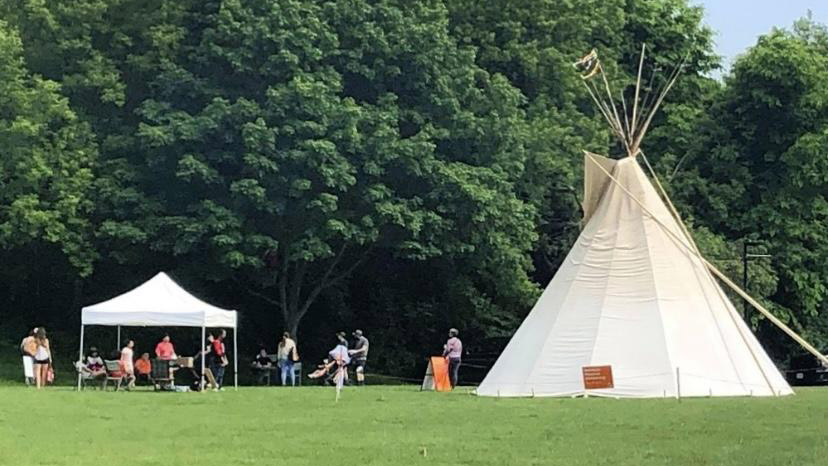The origin of residential schools and their impact today
 CREDIT: AISHA JAVAID
CREDIT: AISHA JAVAIDTeepee and sacred fire at Harris Park to help heal the Indigenous community from the troubling news.
On May 27, a mass grave of 215 children was discovered at a former residential school in Kamloops, B.C. The Tk'emlúps te Secwépemc First Nation employed a specialist to undergo a ground-penetrating radar system to reveal their findings.
The announcement of this tragic event left many distraught and unsettled. An immediate response from the Indigenous community followed.
Challenges such as systemic racism, misrepresentation in educational curriculums, limited resources, land acknowledgement, and many others were a few concerns specified by students of London’s Nokee Kwee, an Indigneous employment and education center, and Grand Chief Joel Abram of the Oneida Nation of the Thames Settlement.
The Indian Residential school system began in the 1880s into the final few decades of the 20th century. This schooling system forcibly split Indigenous children from their families, where they were humiliated, sexually violated, and murdered. The rationale behind this system was based on European integration and an eradication of Indigenous heritage, culture, and language.
Abram’s great grandfather, George Abram was enlisted in WWI.When George returned to Canada from Great Britain after the war, his four-year old son was taken from home and put into the Shingwauk residential school.
“So while he was fighting for Canada, they took his kids away,” said Abram. “At the age of 14, my grandfather ran away from school, which is quite a trip, I would think, as a 14-year-old. And we know that a lot of people didn't make it home.”
The Doctrine of Discovery was the root cause of the mistreatment of the Indigenous people. It served to break one of the oldest treaties, the Two Row Wampum Treaty that symbolized friendship, peace and trust between the Dutch and Iroquois. The Doctrine was composed of policies that operated as religious and political explanations to subjugate the Indigenous people. Essentially, this establishment was developed to permit the colonization of Indigenous people based on racial and religious differences. Abram blames ignorance and the lack of education as the foundation for racism and discrimination.
“I think, you know, we need to really change the education system to face the reality that there are people that are going to have different skin colors, their belief systems, they’re going to talk different than us, but that they are human beings at the end of the day,” he said. Moreover, he mentions the significance of partnership with his community and having the government as allies.
“I think we have a lot of things that we could contribute in terms of the environment, and how everything affects everything else, beginning with water, and the land and principles that we share,” said Abram. For Abram, reconciliation lies in addressing the ongoing battles that the Indigenous community continues to face. For example, the scarcity of potable water and an over-representation of Indigenous children in child welfare systems were indicated by Abram as a few of those struggles that exist today.
One local organization looking to address these issues is Nokee Kwe, an Indigenous-led employment and education center in London, Ont.
Program director Deb Armstrong said they are always looking to help.
“We have many resources and are constantly looking for ways to help anyone and everyone, but specifically the Indigenous people,” she said. “Whether it is for employment or to obtain some sort of certification for training and education, we want to help.”
Armstrong was deeply saddened when she first heard about the tragedy about the remains of the 215 children. She takes great pride in the work ethic and the respectful nature of all her students, and has been employed at Nokee Kwee for over two decades.
“Working with the Indigenous community has greatly helped me mentally and emotionally,” said Armstrong. “I have noticed a great difference in my outlook in life. When I continue to learn about their culture and traditions it all helps bring peace to my mind. For example, when we sit at work, we all sit in a round table, out of respect for every worker. It is not something you would see in other workplaces.”
Indigenous students from Nokee Kwee also reflected on the traumatic effect of residential schools that exists within them.
“Indigenous students are exposed to systemic and overt racism in schools, and they are taught within a colonial school system that I can only imagine must contribute extra stress to the already difficult challenges that students face academically and socially,” said one student.
The last residential school in Canada was closed in 1996. Today, Indigenious families continue to struggle with the traumatic effects caused by these schools. The Truth and Reconciliation Commision of Canada acts as part of the Indian Residential Schools Settlement Agreement, which is determined to document the truth about residential schools in order to help the Indigenous community move forward.















